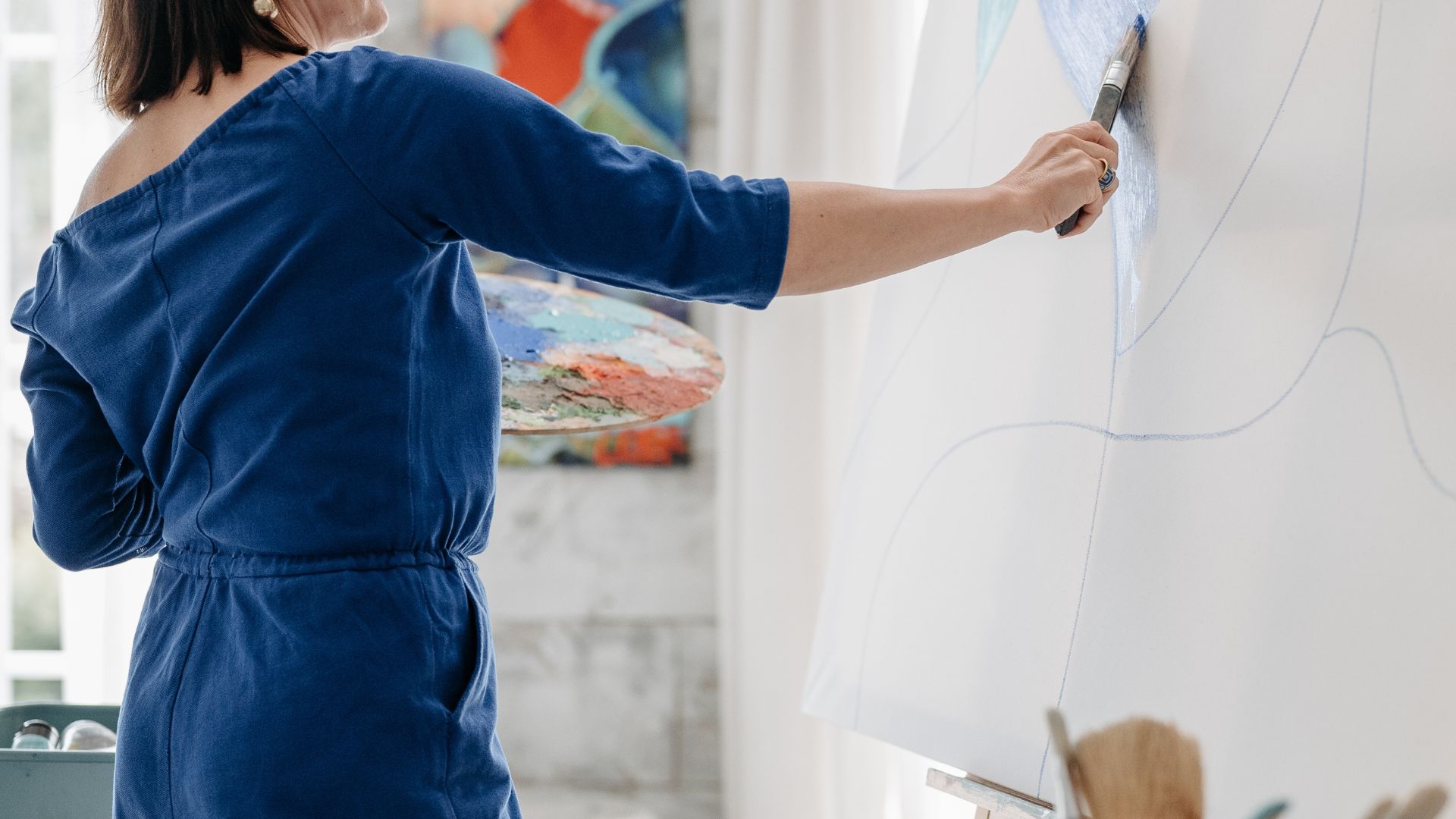When it comes to transforming your walls into captivating artworks, selecting the right canvas is essential. The canvas serves as the foundation for your creation, impacting the final result in more ways than one. Here’s a comprehensive guide to help you choose the most suitable canvas for your wall painting project.
1. Canvas Types
When considering the type of canvas, two primary options dominate the market:
- Cotton Canvas: Known for its affordability and widespread availability, cotton canvas is a popular choice. It’s ideal for beginners and works well with acrylics, oils, and mixed media.
- Linen Canvas: A premium choice, linen canvas offers a smoother surface and greater durability. It’s resistant to moisture and stretching, making it suitable for professional artists or long-lasting projects.
2. Canvas Texture and Weight
The texture and weight of the canvas significantly impact the painting experience and the final look of your artwork:
- Smooth vs. Textured: Smooth canvases work best for detailed work and fine lines, while textured canvases add depth and character to the painting.
- Canvas Weight: Heavier canvases are sturdier and less prone to warping, providing a stable base for your artwork.
3. Pre-Stretched or Unstretched
You have the choice between purchasing pre-stretched canvases or buying canvas rolls and stretching them yourself:
- Pre-Stretched: Convenient and ready-to-use, pre-stretched canvases save time and effort. Ensure the frame’s quality and stability before purchasing.
- Unstretched Canvas Rolls: More customizable in terms of size, stretching your canvas allows you to control the tension and tailor it to your preferences.
4. Canvas Size and Shape
Consider the dimensions and shape of the canvas based on your artistic vision and the space where the painting will be displayed:
- Size: Small canvases are perfect for intricate details, while larger ones allow for expansive compositions. Consider the wall space available.
- Shape: Choose between standard rectangular, square, or custom shapes to complement your design.

An Artist Painting on a Canvas while Holding a Color Palette
5. Priming and Gesso
Applying a primer or gesso to your canvas helps prepare it for painting:
- Primed Canvas: Some canvases come pre-primed, offering a smooth surface and preventing paint from seeping into the fabric.
- Unprimed Canvas: Artists often prefer unprimed canvases to customize the surface with their preferred primer or gesso for specific artistic effects.
External Links for Further Exploration:
- The Science of Canvas Weaves and Surfaces – Artist’s Network
- Canvas Types: Choosing the Right One – Winsor & Newton
- Pinterest: Wall Painting Ideas – Pinterest
- Research Journal: “Impact of Canvas Types on Longevity of Paintings” – Canvas Impact Study
So,…
Choosing the right canvas involves considering various factors such as type, texture, size, and priming. By understanding these nuances, you’ll be better equipped to select the canvas that suits your artistic style and project requirements.
Start your wall painting journey armed with the knowledge of selecting the perfect canvas that aligns with your vision and amplifies the beauty of your artwork.
Remember, the canvas you choose can make a significant difference in the outcome of your creation
Let’s delve further into the nuances of choosing the ideal canvas for wall painting, focusing on additional aspects that play a crucial role in your artistic endeavor.
Understanding Canvas Priming
6. Understanding Priming and Gesso
Priming, also known as gessoing, involves applying a preparatory coating to the canvas before painting. It serves multiple purposes:
- Surface Preparation: Gesso creates a smooth, consistent surface for paint application, preventing the paint from soaking into the canvas fibers.
- Durability: A properly primed canvas enhances the longevity of the artwork by providing a protective barrier against environmental factors.
- Adhesion: Gesso improves paint adhesion, allowing colors to appear more vibrant and enhancing their durability over time.
7. Priming Techniques
There are various techniques for priming canvases, each offering distinct benefits:
- Acrylic Gesso: Versatile and quick-drying, acrylic gesso is commonly used for priming. It’s suitable for acrylic, oil, and mixed media paintings.
- Traditional Gesso: Made from rabbit skin glue and chalk, traditional gesso provides a more absorbent surface and is favored by some artists for its unique texture.
8. Canvas Stretcher Bars
If you opt for unstretched canvas, choosing the right stretcher bars is crucial:
- Material and Stability: Stretcher bars made of durable wood like pine or fir provide stability and prevent warping.
- Bar Thickness: Thicker bars offer more support and are less prone to bending over time, ensuring the longevity of your artwork.
9. Considering Environmental Factors
Environmental conditions can affect your choice of canvas:
- Humidity: In high humidity areas, linen canvases, known for their resistance to moisture, may be a better choice than cotton.
- Storage and Display: Consider where your artwork will be displayed and stored. A sturdy canvas can withstand various environments.
10. Choosing Quality Over Price
While cost may be a factor, investing in a higher quality canvas can significantly impact the final result:
- Long-Term Investment: A high-quality canvas can preserve your artwork for generations, making it a worthwhile investment.
External Links for Further Exploration:
- Choosing the Right Gesso for Your Canvas – Jackson’s Art Supplies
- Canvas Stretcher Bars Guide – Dick Blick Art Materials
- Pinterest: DIY Canvas Painting Techniques – Pinterest
- Study: “Impact of Gesso Types on Longevity of Paintings” – ResearchGate (Insert relevant study ID)
Conclusion
Selecting the right canvas involves a blend of understanding material quality, priming techniques, environmental considerations, and long-term value. By delving into these elements, you empower yourself to make informed decisions that amplify the impact of your wall paintings.
Remember, the canvas you choose not only supports your artistic expression but also contributes significantly to the preservation and aesthetic appeal of your creations.
Comparison tabular
Canvas Comparison Table
| Aspect | Cotton Canvas | Linen Canvas |
|---|---|---|
| Material | Made from cotton fabric fibers | Derived from flax plant fibers |
| Texture | Slightly textured | Smoother texture |
| Durability | Less durable compared to linen | More durable and resistant to moisture |
| Suitable for | Beginners, acrylics, oils, mixed media | Professional artists, long-lasting projects |
| Primed/Unprimed Options | Available in both pre-primed and unprimed | Often available pre-primed, less in unprimed |
| Price Range | Generally more affordable | Higher price point |
| Stretching | Prone to stretching and warping over time | Resistant to stretching, maintains shape well |
| Environmental Impact | Susceptible to humidity, may degrade faster | Resistant to moisture, ideal for humid conditions |
| Longevity | Moderate longevity | Long-lasting and preserves artworks better |
| Recommended for | Small to medium-sized artworks | Larger, high-quality artworks |
This table offers a concise comparison between cotton and linen canvases across various crucial aspects, aiding in your decision-making process based on your preferences, project requirements, and environmental conditions.
Final Words: Deciding on the Perfect Canvas
Selecting the ideal canvas for your wall painting is a crucial step that can significantly influence the outcome of your artistic creation. Here’s a quick recap of key considerations:
- Material Matters: Cotton canvases offer affordability and versatility, while linen canvases boast durability and a smoother surface.
- Texture and Durability: Consider the texture, durability, and resistance to environmental factors such as moisture and humidity.
- Pre-Stretched or Unstretched: Choose between the convenience of pre-stretched canvases or the flexibility of stretching your canvas to tailor it to your preferences.
- Priming and Surface Preparation: Understand the role of priming and gessoing in preparing your canvas for painting, enhancing durability and paint adhesion.
- Longevity and Investment: Quality canvas is a long-term investment that preserves your artwork for years to come. Consider it an investment in the longevity and quality of your creations.
By assessing these factors, you empower yourself to make an informed decision that aligns with your artistic style, project requirements, and environmental conditions.
Whether you opt for a cotton canvas for its versatility or a linen canvas for its durability, remember that your choice sets the stage for your artistic expression. Embrace the canvas that speaks to your creativity and brings your wall paintings to life!
Happy painting and may your chosen canvas be the perfect foundation for your artistic masterpieces!

For over a decade, I’ve been Mike, an artist, crafter, and designer deeply immersed in the Croc world. I thrive on crafting unique, size-inclusive patterns, fostering creativity, and sharing them on ktforum.com. My designs aim to ignite your creative spark and delight you, ensuring clarity and ease of use through rigorous testing. Join me in expressing your creative flair and showcasing your craft with joy.
Related Posts
- Should You Sand a Canvas Before Painting it with Wall Paint
When it comes to using wall paint on canvas, the question of sanding often arises.…
- Can You Paint Over Existing Wall Paint on Canvas
If you're an aspiring artist or someone enthusiastic about trying their hand at painting, you…
- Testing Wall Paint on Canvas: A Smart Approach to Your Painting Project
When it comes to transforming a canvas into a masterpiece, choosing the right paint is…
- Techniques for using wall paint on canvas
Painting on canvas with wall paint can yield fantastic results, but it requires a few…

